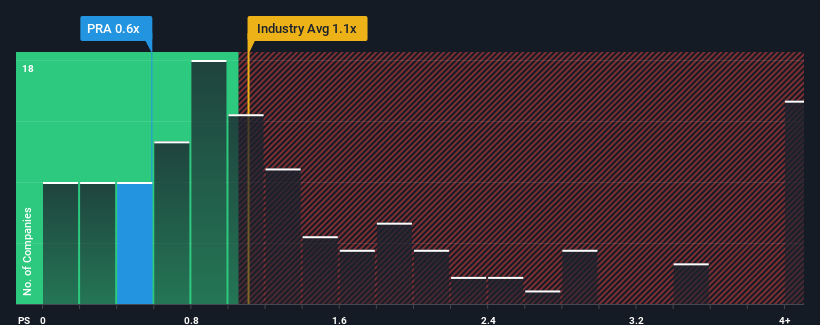- United States
- /
- Insurance
- /
- NYSE:PRA
Lacklustre Performance Is Driving ProAssurance Corporation's (NYSE:PRA) Low P/S
When close to half the companies operating in the Insurance industry in the United States have price-to-sales ratios (or "P/S") above 1.1x, you may consider ProAssurance Corporation (NYSE:PRA) as an attractive investment with its 0.6x P/S ratio. Nonetheless, we'd need to dig a little deeper to determine if there is a rational basis for the reduced P/S.
Check out our latest analysis for ProAssurance

How ProAssurance Has Been Performing
ProAssurance could be doing better as it's been growing revenue less than most other companies lately. The P/S ratio is probably low because investors think this lacklustre revenue performance isn't going to get any better. If you still like the company, you'd be hoping revenue doesn't get any worse and that you could pick up some stock while it's out of favour.
Want the full picture on analyst estimates for the company? Then our free report on ProAssurance will help you uncover what's on the horizon.Is There Any Revenue Growth Forecasted For ProAssurance?
There's an inherent assumption that a company should underperform the industry for P/S ratios like ProAssurance's to be considered reasonable.
Taking a look back first, we see that the company managed to grow revenues by a handy 5.0% last year. The latest three year period has also seen a 28% overall rise in revenue, aided somewhat by its short-term performance. Accordingly, shareholders would have probably been satisfied with the medium-term rates of revenue growth.
Looking ahead now, revenue is anticipated to slump, contracting by 2.8% during the coming year according to the four analysts following the company. That's not great when the rest of the industry is expected to grow by 5.3%.
With this information, we are not surprised that ProAssurance is trading at a P/S lower than the industry. However, shrinking revenues are unlikely to lead to a stable P/S over the longer term. Even just maintaining these prices could be difficult to achieve as the weak outlook is weighing down the shares.
What Does ProAssurance's P/S Mean For Investors?
Typically, we'd caution against reading too much into price-to-sales ratios when settling on investment decisions, though it can reveal plenty about what other market participants think about the company.
With revenue forecasts that are inferior to the rest of the industry, it's no surprise that ProAssurance's P/S is on the lower end of the spectrum. As other companies in the industry are forecasting revenue growth, ProAssurance's poor outlook justifies its low P/S ratio. Unless there's material change, it's hard to envision a situation where the stock price will rise drastically.
Many other vital risk factors can be found on the company's balance sheet. You can assess many of the main risks through our free balance sheet analysis for ProAssurance with six simple checks.
It's important to make sure you look for a great company, not just the first idea you come across. So if growing profitability aligns with your idea of a great company, take a peek at this free list of interesting companies with strong recent earnings growth (and a low P/E).
New: Manage All Your Stock Portfolios in One Place
We've created the ultimate portfolio companion for stock investors, and it's free.
• Connect an unlimited number of Portfolios and see your total in one currency
• Be alerted to new Warning Signs or Risks via email or mobile
• Track the Fair Value of your stocks
Have feedback on this article? Concerned about the content? Get in touch with us directly. Alternatively, email editorial-team (at) simplywallst.com.
This article by Simply Wall St is general in nature. We provide commentary based on historical data and analyst forecasts only using an unbiased methodology and our articles are not intended to be financial advice. It does not constitute a recommendation to buy or sell any stock, and does not take account of your objectives, or your financial situation. We aim to bring you long-term focused analysis driven by fundamental data. Note that our analysis may not factor in the latest price-sensitive company announcements or qualitative material. Simply Wall St has no position in any stocks mentioned.
Have feedback on this article? Concerned about the content? Get in touch with us directly. Alternatively, email editorial-team@simplywallst.com
About NYSE:PRA
ProAssurance
Through its subsidiaries, provides property and casualty insurance, and reinsurance products in the United States.
Moderate growth potential with mediocre balance sheet.
Similar Companies
Market Insights
Community Narratives




